
- Index
- Band
- Am / Fm (78)
- Am / Fm, Uhf, Vhf (22)
- Am, Fm, Uhf, Vhf (13)
- Dual Band (11)
- Fm, Uhf, Vhf (57)
- Hf / Vhf / Uhf (7)
- Hf, Uhf, Vhf (13)
- Uhf (450)
- Uhf / Vhf (35)
- Uhf Vhf (9)
- Uhf+vhf (13)
- Uhf, Vhf (222)
- Uhf, Vhf, Am / Fm (11)
- Uhf, Vhf, Fm (8)
- Uhf, Vhf, Hf (17)
- Vhf (262)
- Vhf / Uhf (18)
- Vhf+uhf (50)
- Vhf, Uhf (17)
- 800 (14)
- ... (2098)
- Brand
- Memory
- 1000 Channels (13)
- 128 Channels (54)
- 16 Channels (26)
- 16ch (16)
- 199 Channels (2)
- 200 Channels (23)
- 300 Channels (7)
- 3000 Channels (30)
- 3000 Channles (21)
- 32 Channels (2)
- 4 Channels (2)
- 256 (3)
- 512 Channels (5)
- 8 Mb (11)
- 809 Channels (5)
- 999 Channels (3)
- More Than 800 (5)
- Up To 128 Channels (2)
- 809 (4)
- ... (3191)
- Model
- Service
- Type
- Antenna (132)
- Antenna Analyzer (37)
- Base Station (92)
- Calling System (85)
- Desktop (24)
- Handheld (23)
- Handheld Transceiver (16)
- Mobile (27)
- Mobile / In-vehicle (261)
- Mobile Radio (33)
- Mobile Transceiver (17)
- Portable (31)
- Portable / Handheld (407)
- Portable Radio (24)
- Receiver (16)
- Repeater (22)
- Shortwave Radio (20)
- Transceiver (40)
- Transverter (18)
- Two Way Radio (19)
- ... (2081)
Icom IC-R9000 AM FM SSB CW Shortwave Receiver 100 Khz -1999.8 Mhz DC-DAYLIGHT
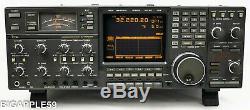
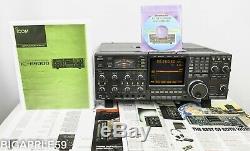
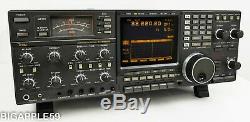
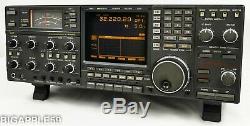
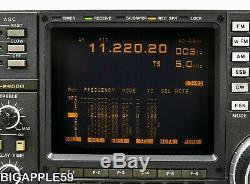
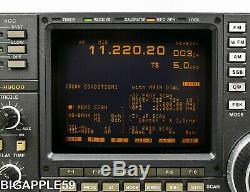
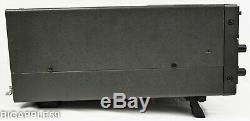
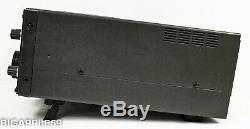
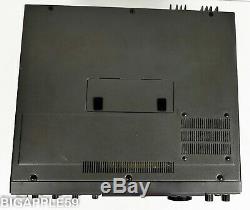

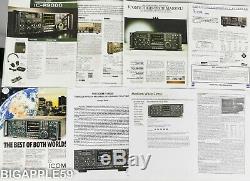
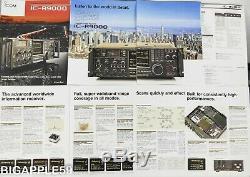


Where necessary in our sale details below. This sale is for an highly reviewed and revered Icom IC-R9000 receiver built from 1989 thru 1998.
Many hobbyists consider the R9000 to be the epitome of receivers due to its excellent sensitivity, wealth of operational features, spectrum display, and unbroken (unblocked) coverage from 100 KHz thru 1999.80 MHz. Cosmetically, the receiver is used and in above average cosmetic condition.
The top plate is often missing and this unit's cover plate is present and in wonderful condition. We have verified that this R9000 operates wonderfully with excellent sensitivity. We did not operate the unit above 1,000 MHz since we do not have the proper antenna nor are we familiar with transmissions to test the receiver in this range, but we expect the receiver will work just as well in those upper ranges as it does in the lower ranges. The unit works well with no known issues or problems and we did not spot any noticeable burn-in on the CRT screen. We reduced the screen intensity of the CRT so that you can observe the absence of screen burn-in. It is also common for these receivers to have CRT distortion or improper screen alignment and neither of these issues is present with this receiver. The R9000 is supplied with a copy of the user manual. In addition, there is a copy of the brochure, promotional documents, reviews, and the Passport Whitepaper review.Please note that this receiver also comes with a CD that contains many of the documents listed above plus the service manual. Typically when someone looks to purchasing a "do all" receiver, they soon find that they run into a list of compromises. Additionally, if you want a wideband receiver to scan, it is usually limited with what it can perform and this leaves the operator frustrated and wanting more channels, banks, speed, etc.
Thus, the person likely ends up purchasing a combination of receivers to get the band coverage and features that one is desiring to have available to them. In 1989, Icom introduced the IC-R9000 to the consumer market with high acclaim. Certainly this was not a receiver for the amateur hobbyist!During the 10 years that Icom made this receiver, it received numerous "high five" reviews from those who were fortunate enough to be able to get their hands on the receiver and put it through its paces. Finally, here was a receiver that could do all things well and as close to perfection as you will ever likely find in a DC to daylight receiver that offers scanning capabilities. We now intend to explore some of the receiver's features and capabilities at this time in the listing.
Let us point out that when you look at this receiver, you are immediately struck with the fact that this receiver is unlike any receiver you have probably encountered. The outstanding difference is that Icom employed the use of a large front panel display to help with both signal location and with programming. We would like to summarize some of the features found on the R9000 and then take a little time to discuss some of them. 5.5 diagonal CRT for spectrum display, terminal monitor & operational functions. Unbroken and unblocked receiving range of 100 KHz to 1999.8 MHz. Separate Bass / Treble controls. 1 / 1 / 5 / 9 / 10 / 12.5 / 20 / 25 / 100 (thus tuning resolution of 10 Hz). Selectivity 150 / 15 / 6 / 2.4 /. 5 KHz (depending upon receiving mode).Super high frequency stability + or - 25 Hz less than 30 MHz and = or. 25 ppm over 30 MHz.
AFC thru the entire FM range (like 1200 MHz in amateur bands or to compensate for frequency shifts of doppler effect from weather satellites). Excellent sensitivity on all frequencies. Improved CI-V to control the unit from a personal computer.Line out , external speaker and 1/4 headphone jacks. Noise Filter that is threshold adjustable and width selectable. 10 / 20 / 30 dB attenuator. And then there are features specific to the scanning functions.
Adjustable scan speed (but based on about 13 channels / sec). Programming scanning ranges & memories using the CRT scope. VSC function (voice scan control) - scans immediately when a voice is not detected upon scan pause. Programmed Scan - Repeatedly scans between two programmable scan edges. Up to 10 groups of scan ranges can be specified.F Scan - Repeatedly scans pre-selected frequency widths around your receiving range. Useful for signal searching in a narrow frequency range. Priority Scan - Monitors the memory channels while you listen to your main operating channel. Your most required memory channel may be programmed as a priority channel for each memory bank.
(good for public service call out frequencies). Memory Scan - Scans all memory channels or a pre-programmed memory channel range i. Selected Mode Memory Scan - Scans memory channels which contain the same specific mode. Selected Number Memory Scan - A group number can be assigned for all 1,000 memory channels. This search then will only scan only those channels that contain the same group number. Auto Memory Write Scan - Scans between two scan edges and when a signal is received, writes the channel sequentially into memory and also writes the received time into the note area. At this point, we would like to talk a bit about the strengths and shortcomings of this receiver.We have often been asked what is our favorite of all the receivers we have ever tested. This is akin to asking a parent which is their favorite child. Each receiver has a personality and shines in some areas while lacking in others. For us, the R9000 is not perfect, but is very close. As you can tell from the list above of receiver's features and specs, it is a phenomenal receiver.
We have personally owned one and used it for about 6 years so can answer a number of specific questions. However, as much as we have used the unit, there are many features that we have never explored and are lacking in familiarity. If you like buttons, dials, controls and user options....
This is a dream receiver that will hold your interest for some time. The other purpose is for DXing and, in using the spectrum display for mediumwave and HF reception, discovering new transmissions or working to improve reception with what we see on the scope. You basically use the unit like a regular receiver with all the bells and whistles of IF shift, notch, filter selection, etc, etc. However, instead of working on a difficult signal blindly, you can observe it in the spectrum scope.This helps you observe the presence of other nearby signals and efficiently move away or minimize the interference. Otherwise, you don't "see" the signal and don't know what you need to do. Yes, you can figure it out, but the visual using the scope is a great way to do this with ease. Secondly, we use the scope to spot signals. You can set the spectrum display to read + or - 25, 50 or 100 KHz and using it like a radar screen, discover signals that you may otherwise overlook or tune past.
On our R9000, we set the scope to read + or - 25 KHz and then set the tuning step at 5 KHz when searching shortwave. This means that in looking at the grid on the display, we can accurately know the frequency of the signal before tuning toward it. Then as necessary, we can make the tuning resolution finer for tropical band use or zeroing in on sideband signals. When DXing on mediumwave, we can see signal peaks at every 10 KHz and it helps to visualize the strength of the signals up and down the band. On the ham bands, this display becomes very important in assisting in optimizing signals.
With a tuning resolution of 10 Hz, you can get perfect SSB and, using a variety of weapons previously mentioned, deal with both QRN and QRM. On our personal R9000, we programmed about 100 channels on the higher frequencies that are mostly public service in nature. The display allows you to easily load this information and see it during entry.Admittedly, we do not use the scanning feature as often as direct entry of frequencies or of listening on the HF bands, but it is nice to have this feature when we need to call upon it. Others will undoubtedly find a lot of use with the versatility of the scanning features. Here is a list that should not be considered exhaustive. Longwave transmissions including broadcasts within Europe or Asia as-well-as beacons & utility broadcasts. All the amateur radio frequencies of 160 thru 2 meter plus all the high band and satellite communications.
Military traffic (that is on open channel and not scrambled). Emergency services as fire, police, ambulance, hospital, lifeflight. Road repair and clearance crews.
Prison traffic (security, of course). University maintenance and security traffic. City Transit Systems (buses, metros, trains, etc). Wireless microphones / baby monitors , etc. Amusement park traffic (Disney has a large network).
Space communications & satellite communications (if open channel). As we have mentioned, we do not utilize the full scanning capabilities of our R9000. Our preference is to direct dial in certain marginal frequencies.
We were able to download hundreds of frequencies available to us in our area (found in various online databases) and from time-to-time, print them out for reference, and then punch them in on the R9000 keypad. Some of these frequencies are rather obscure and not necessary to have in memory.
For instance, we were able to tune into our neighbor one day as he was on his farm tractor communicating to his farm hands in the barn. We had no interest in this transmission and while we have never tuned in any other time, we found it fascinating the scope of signals for what this receiver can pull in.
On another occasion, when our daughter was late coming home from school, we were able to tune into the school district frequency and learned that there was an accident on the road ahead of the school bus that was holding up the bus traffic and thus delaying school bus drop offs. Our personal experience with this receiver is that it is possibly the best wideband receiver ever made.... Or at the very least the best that will ever be made for the consumer market in this price class. (this is personal opinion, but backed by other opinions as well) Why is that?First of all, there are no gaps in the receiving range and that is virtually impossible to achieve anymore as only government receivers can now offer that type of coverage. Secondly, Icom released a follow up to the R9000, the R9500 and the R2600.
However, while the receivers multi-color display are striking to look at, they also have some issues with circuit noise coming from the massive LCD display affecting the readout on the spectrum screen. A well respected electrical engineer told us that the circuit noise level on the readout of the 9500 means that it is worthless for weak signal searching due to the "grass" on the screen and this can also be seen on the screen readout for the R2600 receiver. We have tested this on both of these receivers and found this to be true and that Passport's review of the R9500 also confirms this information.
The R9000 is an exceptional unit, but does have a couple of shortcomings as well. (remember, there are no perfect receivers) First of all, the power supply runs hot from AC. If you should want to negate some of the heat, there are several solutions for this heat issue like Sherwood Engineering's replacement back panel that has a built in fan. Since the R9000 also accepts DC current, this was easy for us to utilize and determines that all the internal components stay on the cool side.
We have operated our R9000 using DC and our Astron power supply and the receiver stayed on the cool side which tends to prolong the lifespan of components. Anyway, Sherwood can install extra filters and in using the Sherwood SE-3 synchronous detector, you have a combination of solutions that takes this R9000 from an exceptional receiver to an ultimate one.
Yes, there is a cost and you can decide if the gain is worth the additional cost. At this point, we would like to provide you with some external links to learn more about the R9000. Here is the mother of all links from Radio Reference. This site is the Rigpix site that offers little extra info, but does have a link for you to view the manual. Here is an excellent complete review on the Medium Wave site and first offered on the Radio Netherland site.And this final site is the eHam site giving reviews by other users of this R9000 receiver. The item "Icom IC-R9000 AM FM SSB CW Shortwave Receiver 100 Khz -1999.8 Mhz DC-DAYLIGHT" is in sale since Thursday, March 26, 2020.
This item is in the category "Consumer Electronics\Radio Communication\Ham, Amateur Radio\Ham Radio Receivers". The seller is "bigapple59" and is located in Mill Hall, Pennsylvania. This item can be shipped worldwide.
- Model: IC-R9000
- Country/Region of Manufacture: Japan
- Band: AM
- Type: Base Station
- Supported Modes: AM
- MPN: IC-R9000
- Brand: Icom

